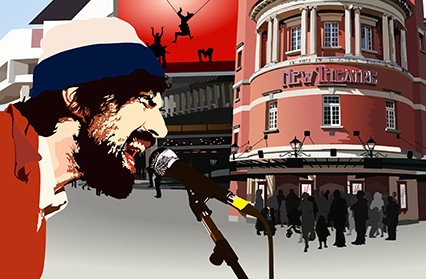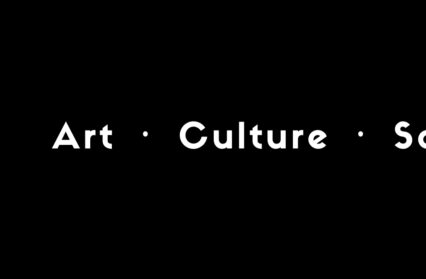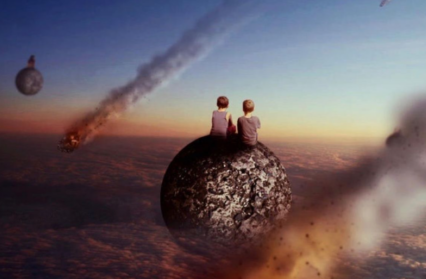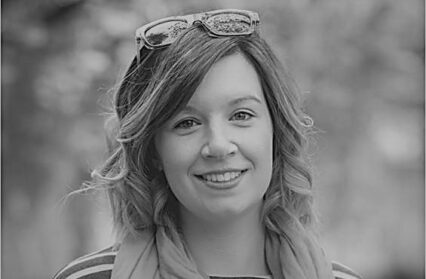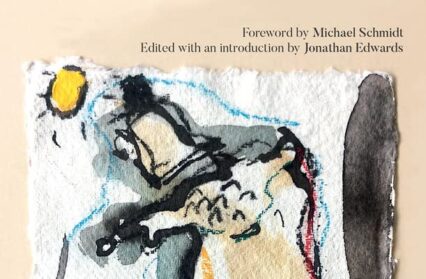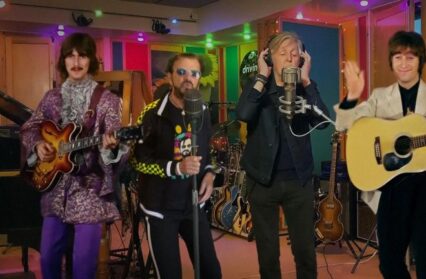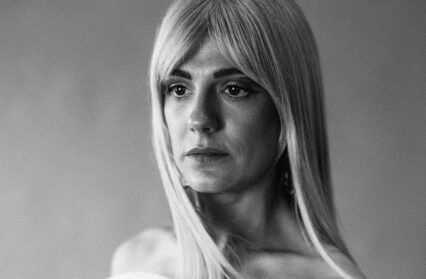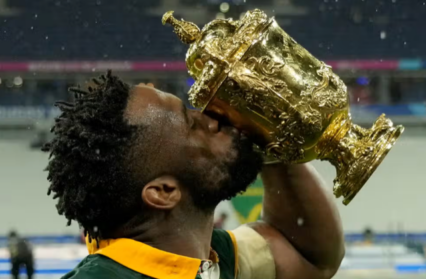It’s that time of year again, and Wales Arts Reviews‘ writers have been choosing their cultural highlight of the year. The brief was simple; it had to be something that happened in 2014 and it had to be something that left a mark on that writer’s psyche. In three parts, we see impassioned writing on a diverse range of subjects, and also see the emergence of a striking cultural map of 2014. In Part Three, we have tributes to Cynan Jones, Sian Phillips and the late, great Kim Fielding.
Francesca Montemaggi
More than a horror, Babadook is a tale of a woman’s sense of inadequacy before society’s conventions and expectations. Australian director, Jennifer Kent, reinterprets F.W. Murnau’s Nosferatu (1922) to give voice to today’s fears. Nosferatu was inspired by Bram Stoker’s Dracula; yet the character of Count Orlock deviated significantly from Dracula. Count Orlock lacked Dracula’s gentlemanly charm. Conceived during WWI, Orlock was the spectre of the terror that haunted the nation. Accompanied by rats, Nosferatu is a demonic darkness that falls on a sleepy German town like the plague. (The polluting evil in Nosferatu is clearly a metaphor for the Jews).
The Babadook at first appears through an infestation of cockroaches in an ordinary home in white middle class suburbia; yet the dirt does not symbolise a moral panic. It is a psychological breakdown of someone oppressed by social conventions. The Babadook resides in the terrified minds of a mother and her child. Amelia lost her husband in an accident on the way to the hospital to have her baby Samuel. Since then, she has not completely recovered from the trauma. Samuel is a difficult child and Amelia suffers the judgement of other parents, teachers, and of the audience.
Babadook is conjured by a book, which Samuel finds in the house appearing out of nowhere. Amelia reads it to Samuel, but he gets frightened and the book is put aside quickly. Yet, it has already taken hold of Samuel, who becomes even more intolerable. Amelia’s inability to control him makes her isolated in her community. Kent weaves in the hypocrisy of a society which decrees that children be at the centre of a parent’s life, often dominating it, whilst expecting parents to control them. Amelia’s life is ground down by a monotonous and unfulfilling job as a care worker and an unruly child, in stark contrast with the suburban perfect life of her sister and her friends. Samuel’s obsessive fear of the Babadook and its supernatural manifestations begin to haunt Amelia too. She can no longer function in society. She stops going to work, her son is expulsed from school, and social services march in. Outside society is just as oppressive and terrifying as the supernatural horror at home. Painted from a dark grey palette, the ‘outside’ is an indifferent and austere world that proceeds relentlessly. Amelia’s mental breakdown is almost the refusal to play society’s game. She cannot win. She looks for a place that is ‘nice and warm,’ as she comments, while sitting fully clothed in her bathtub. Samuel watches her mother becoming possessed by the Babadook. Amelia’s vomiting and strange behaviours echo The Exorcist, but it is the silhouette of Nosferatu that looms large in Amelia’s house.
Nosferatu, the spirit of the Babadook thirsts for blood and victims. He requires sacrifice and Amelia, while possessed, duly complies. In Nosferatu, the evil darkness is dissolved by light, an innovation on the myth by Murnau. In Babadook … that is for you to find out.
Gary Raymond
It’s been a strong year for festivals. A strong year for festivals in what may be looked back upon as The Age of the Festival. For Wales Arts Review, our live rolling coverage of Green Man, a fabulously warm independent festival just outside of Crickhowell, was an important experiment for us a media outlet. Four of us, intrepid writers all, spent the four days blogging our way out of the paper bag, absorbing and then relaying as many of the myriad experiences on offer. Not just a few bands on no more, oh no. Festivals are a very different thing nowadays. In fact, you could spend the whole time at a place like Green Man, see not one band, and come way utterly fulfilled and exhausted.
But Green Man, exhilarating, enjoyable, and professionally fulfilling as it may have been for me this year, is not my highlight; rather it is something that sprouted out from the centre of that festival in the lush greenery. August was the month in which two figures of an older generation reminded many not only of their creative power, but of the significance of the work they put in decades ago, of the foundations they helped make secure.
At Green Man, Shirley Collins in interview was not simply a festival highlight but a highlight of the year. She spoke of her life, her dramatic ups and downs, the characters she knew in the English and American folk and blues scenes, the life lived in time with the evolution of Western music. When Shirley Collins first made records, British teenagers hadn’t heard of Elvis. Now Bonny Prince Billy is covering her songs. Now in her late seventies, she is wise, funny, forthright without being the slightest bit curmudgeonly – there is a campaign to make a documentary film of her life, and we should all keep our fingers crossed it comes about.
But August also saw the release of an album – my album of the year – by one of Shirley Collins’ contemporaries, almost her transatlantic doppleganger in many ways: Peggy Seeger. At 79, Seeger’s stunningly beautiful Everything Changes is an album that belies the idea that songwriting no longer need be at the centre of musical creativity. Everything Changes, is profound, melancholic, hilarious, beautiful and experimental. In turn it will bring you as close to jiving as it will to tears. In a year when the mainstream press have lauded the returns of Cohen, Gabriel, and paid column inches to the yawn-fests The Who and even U2 have offered up, it is the quiet contemplative, fanfare-less work of the women that have brought the most satisfaction. The only tribute you need to the awful tragedy of the sinking of the Titanic is in Seeger’s radio ballad ‘Swim to the Stars’, which would also probably double as the best song of the year, had she not outdone it herself with the album’s title track and the painfully beautiful reflective masterpiece ‘When Fairy Stories End’, a song that has the power to make you feel like it has always been there, a classic of the oldest variety, that turns simple chord changes into heartbeats.
(The album also has the best Christmas song in decades, which parades Santa with a rather needy Tooth Fairy and an even more needy Dracula).
I wasn’t expecting it, but 2014 has been a year for looking back, looking at the Titans who built our world, and realising they still have the best stories to tell.
Jemma Beggs
As I cast my mind back over the past year, I feel extremely lucky to have a wealth of potential choices for my 2014 cultural highlight. I have attended some simply spectacular dance performances, listened to certain songs so many times I’m sure my neighbours would cheerfully murder me given half the chance, and of course, read some fantastic new books that I will no doubt be rereading in the future. However, my favourite experience this year was one made possible by Wales Arts Review itself and it towers above all others as being a true highlight, not just of this year, but one I know will stay with me for some time.
After a day of engrossing and impassioned debate at WAR’s Roundtable event, Sian Phillips stepped forward to read an extract from Caradog Prichard’s Un nos ola Leuad which had just been crowned the Greatest Welsh Novel of all time after a year long debate ending in a public vote. I will promptly admit that I had never read this book, nor even heard of it before the nominations took place throughout the issues of WAR this year, but if anything would send me racing for the nearest library it was this reading.
Sian Phillips undoubtedly captivated the entire room for the duration of her magnificent reading, but what really made this moment outstanding for me was my personal experience of it. As I listened I completely forgot I was in a room full of people, some of whom were friends, some strangers (and some I am very much in awe of) and became entirely consumed by the wonderful storytelling, in such a way that I haven’t felt since becoming an adult.
It is a very specific and personal, albeit slightly paradoxical, feeling of certain safety and thrilling possibilities which I associate with my childhood, of being read to by somebody and unconsciously allowing myself to fall headfirst and unreservedly into an entirely different world, one from which I always emerge a little dazed and surprised to find myself exactly where I was before.
Sian Phillips did a sensational job, limited as she was to a short space of time with just an extract of the novel, and it was her obvious love and pure enjoyment of the book which truly brought the story to life (not to mention her enthralling voice!). I would not be at all surprised to see this feature in other WAR’s highlights as it was a truly wonderful experience and for me can easily be captured in a single word, quite simply – magical.
John Lavin
2014 was a strong year for the Welsh novel, treating us as it did, to supremely confident new outings from Sarah Waters (The Paying Guests), Jo Mazelis (Significance) and Matthew Francis (The Book of the Needle), while also offering a series of remarkably assured debuts from the likes of Carly Holmes (The Scrapbook), Rhian Elizabeth (Six Pounds, Eight Ounces) and Dan Tyte (Half Past Seven). And then, almost as though to rubberstamp this near irrepressible confidence in contemporary Welsh literature, one small book towered above not only its Welsh peers but also its international ones. The novel in question – unquestionably my novel of the year – is, of course, that short, precise meditation on badger baiting in west Wales, The Dig. To say that Cynan Jones’ third novel is a revelation is partly to do a disservice to the consistently high quality of the Ceredigion writer’s previous output but at the same time a revelation is just what it is. The minimalistic, poetic style that Jones has honed over the past decade comes to fruition in this extremely powerful work; aided by what is certainly the most ideal crucible that Jones has found to date for his ideas – the horrific world of the badger dig.
In The Dig, Jones examines brutality and frailty not only with the eye of a surgeon but also with the heart of a poet. It is a novel that is, while rooted in the rhythms and realities of the Ceredigion landscape in which it takes place, a work of great metaphorical power and resonance. And one that I firmly believe will be read and admired for many years to come.
Bethan Tachwedd
My highlight of the year was Richard Linklater’s Boyhood, a cinematic project both utterly unique but also compellingly and unwaveringly traditional at the same time. A film that has enjoyed a slow burn hype over the last several years, it arrived with suitably high expectations foisted upon it and certainly lived up to them.
There was a definite sense of an intentionally direct communication between Linklater and the audience throughout the film. The story was his, his characters’, and ours in equal measure. The performance of Ellar Coltrane was assured from the very beginning and it was fascinating to watch the character, as well as the actor, grow in confidence and a very clear sense of self, over the duration of the one hundred and sixty five minutes. A long film, but one where even the running length seemed part of the overall message: life is long, time is unstoppable, we must wait to see how it develops.
Ethan Hawke gave a great performance, assured and ego free. Some critics commented however that his presence in this Linklater film was something of a distraction given their strong association from previous, iconic, projects. This wasn’t a problem for me as such, but I concede the point being made.
One review placed Boyhood as a definitive cinematic experience. I’m not sure that I agree with this. It is a brilliant coming of age narrative, handled professionally and with the assuredness you would expect from an auteur of Linklater’s pedigree. The real joy of the film for me was seeing a high art concept being placed at the centre of a mainstream film and pulling it off in a way that was accessible and would have worked equally as well for a viewer with no preconceptions.
Other than Linklater, Coltrane and Hawke’s Boyhood, what has struck me most about 2014 from an arts, and indeed political, perspective in Wales and further afield, is that there has been a shift in the tectonic plates of power. The gatekeepers of old, from publishers to prehistoric unionists, have been given an unequivocal message that their time, if not quite over, is certainly coming to an end in the not too distant future. I would highlight Wales Arts Review as being a part of this shift; certainly its successful crowd funding project has shown that the consumer or individual can take responsibility and play a direct part in creating the content that she/he wishes to consume. This is an essential reality that people in the arts need to recognise, and it was heartening to see new voices emerge in fiction, voices that are not afraid of controversy or putting noses out of joint. There is a discussion happening, whether everyone likes it or not. As Ethan Hawke remarked in Reality Bites: ‘You see, this is all we need. A couple of smokes, a cup of coffee… and a little bit of conversation.’
Joao Morais
The highlight of the year for me was also my highlight of the Cardiff Contemporary, the inaugural city-wide festival of art held throughout October. Paradise LOST was a show held in tribute to the late Kim Alexander Fielding, who as well as being a fantastic photographer, used to head up the tactileBOSCH gallery in Llandaff North. He died in February of this year.
It’s hard to describe Kim if you never met him. Imagine a man who was equal parts Andy Warhol, Big Gay Al from South Park, and whirling dervish. He could be everywhere at once, and had the pictures to prove it. Many believed he somehow managed to sneak into the third Harry Potter novel and steal Hermione Granger’s time turner. My earliest forays into writing for Wales Arts Review when it first launched were twinned with Kim’s photographs, as we used to go to many shows together. But here’s the thing: I was so used to writing fiction I found it difficult to tell the truth in any other meaningful way. I removed myself from the page. This is the complete opposite of what Kim would do from behind the lens. ‘I read your review,’ people would say to me. ‘The pictures are amazing.’
Paradise LOST recreated a show as if Kim had curated it. Much like Wagner’s theory of the Gesamtkunstwerk, Kim made each show to be a total and immersive work of art in itself, often doing away with labels to say which piece belonged to which artist, while basing the work’s location in the gallery around the space he felt it best commanded. He didn’t refer to himself as the ‘instictator’ for nothing. Each show, despite always being in tactileBOSCH, was like entering a dark new world.
The organisers of Paradise LOST– now the steering group of the Kim Fielding Award – got everything right. The location, in the old immigration building down the Bay, was left alone as much as possible. Paint peeled off walls, ancient debris such as old cast-iron safes filled rooms, boarded-up windows let through minimal cracks of light. A cast of 90 artists, all connected to Kim in some way, filled this huge building equally with art, grief, and love. Every room from the cellars to the attic held a piece of work. It was one of those shows that, if you knew him, was impossible to see through the eyes of anyone but Kim Alexander Fielding.
He could have been there. At any one time, you expected to hear his pig-snort of a laugh, or hear him say how everything, no matter how good or bad, was either gnarly or barking. You expected him to introduce you to ten people while taking pictures before going off to do the same with everyone else. Then you expected to have a pint with him afterwards and you would know he was drunk because his quiff would flop into his eyes.
Oh Kim, my beautiful Kim. Why the fuck did you have to die?
original illustration by Dean Lewis


